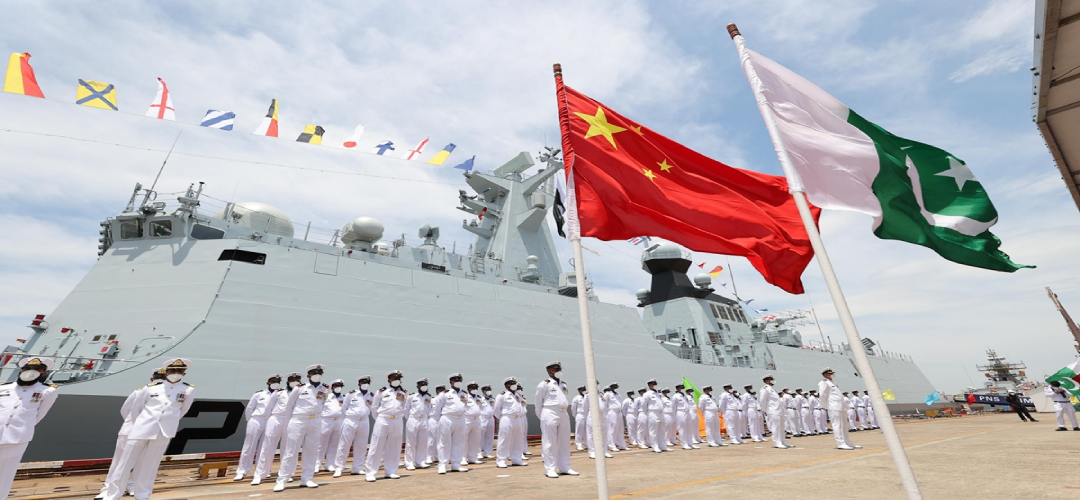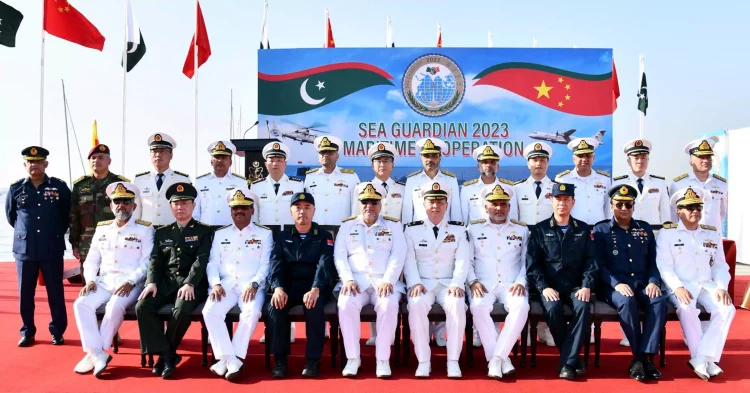Maritime Collusion in the Arabian Sea
December 2, 2023 | Expert Insights

India's maritime neighbourhood is a key component of its overall security framework as it strives towards its five trillion economy target. This maritime zone of India is divided into two parts: the east and the west. In the east, the water body of the Bay of Bengal is crucial for India's naval security. The focus of the western maritime zone is primarily the Arabian Sea.
While frequent intrusions of major platforms, including nuclear-powered submarines, of the People’s Liberation Army Navy (PLAN) keep the Indian Navy on its toes in the Bay of Bengal, the threat in the Arabian Sea in the past has largely been from the Pakistani Navy. However, as the recent exercise demonstrated, the maritime challenges to India are undergoing dramatic transformations.
China and Pakistan conducted combined naval exercises in the northern half of the Arabian Sea this year from 11th November to 17th November. Islamabad and Beijing hailed This exercise as the first of its kind between these two allies. The Pakistani side hosted the exercise. According to Pakistani officials, this exercise would improve the joint operational capabilities of the two navies to deal with maritime security challenges.
Background
The Arabian Sea is significant to India in many different ways.
It connects India to the wider world. On the other side of the Arabian Sea lie the countries of the Persian Gulf, some of the world's major energy producers. Over the years, India has built a close relationship and linkages with these countries.
In 2008, Pakistan unleashed the phenomenon of sea-based terrorism on India in the form of the now infamous 26/11 Mumbai attacks. Seizing control of an Indian trawler after killing its entire crew in cold blood, the Lashkar e Tayyaba terrorists successfully evaded Indian coastal surveillance to write the deadly chapter of the Mumbai massacres. For the first time, the direct security vulnerability of the Arabian Sea was clearly and painfully exposed since the 1965 naval raid on Dwarka port by Pak Navy naval assets.
However, security experts had been warning of such an eventuality, considering that the Arabian Sea coastline of India is a notorious hotbed for smuggling gold, drugs, counterfeit Indian currency and later weapons and explosives. It may be recollected that the 1993 serial Mumbai blasts were caused by nearly 3,000 kg of RDX landed on the coast at Shekhadi in Raigad district. Over 200 innocent civilians were killed in the ensuing 12 major car bombs.
Monitoring such activity has become increasingly difficult over the years. This has become the soft underbelly of India. India's financial capital, Mumbai, is vulnerable to this security threat. Connectivity with the Middle East will also be hampered if any disruption in the Arabian Sea. Hence, the stakes are very high for India.

Analysis
These exercises have to be seen in a broader perspective. There is a larger geo-strategic game plan going on in here.
This is China’s long-term intention of containing India within its neighbourhood. The neighbourhood in question is the Indian Ocean Region. China is looking for like-minded countries with an axe to grind against India. Pakistan is the most prominent of these countries.
Islamabad considers the Arabian Sea within its naval sphere of influence and would like to challenge the Indian maritime presence in this sea. But on its own, it cannot face up to the markedly superior Indian naval power and, therefore, needs an ally in its long-term naval contest against India. China would be a natural ally in this endeavour.
China does not have a permanent naval presence in Pakistan. This is due to a number of reasons. First, Pakistan has no facility to host a large Chinese fleet. Second, Beijing does not want to put all its maritime assets in the Pakistani basket. Under its “String of Pearls” strategy, China has diversified its South Asian ventures. Naval bases have been set up in all the main countries surrounding India. All these bases have strategic locations. The Chinese Navy has special basing rights in these port facilities.
In Pakistan's case, this is the port city of Gwadar. Previously, this was a small fishing village. However, Chinese investments have changed this completely. The development of Gwadar has given China access to the Arabian Sea and a strong foothold near the strategic Strait of Hormuz through which most of the world’s energy supply passes. Using the Gwadar base, PLAN could choke India's energy supplies from the Persian Gulf region in case of hostilities.
From India’s perspective, the security of the Arabian Sea is ultimately linked to the wider Indian Ocean and the Indo-Pacific. However, expecting the U.S. or other QUAD members to help protect India's critical sea lanes of communications in a conflict scenario would be unrealistic. Ultimately, India must secure its supply routes passing through the Arabian Sea.
This is not the first joint naval exercise between Pakistan and China. Sea Guardian exercises have been taking place between these two countries regularly for quite some time now. Normally, these exercises occur within Pakistan or China's territorial waters. Thus, they did not directly challenge India.
Pakistani authorities have hyped up the significance of this joint exercise between the two countries. The scale of this exercise is only marginally bigger than what usually takes place. PLAN deployed a Song class submarine, a destroyer, two guided missile frigates and a supply ship. This is not much different from China’s earlier naval collaborations with Pakistan. Pakistan contributed nine warships, four fighter jets and one maritime patrol aircraft for this exercise.
This is the third time the People's Liberation Army Navy (PLAN) and the Pakistani Navy have come together for the "Sea Guardian" exercises. Two earlier versions of this exercise have already taken place. The first occurred in January 2020 in the north of the Arabian Sea. The second one was held in the East China Sea in July 2022. These were regular engagements, but they were preceded by the annual bilateral exercises between the two countries, which have been taking place since 2014.
No other country has taken part in these exercises. Iran is not interested in any such arrangements. It wants to maintain good relations with India. The Arabian Sea is not strategically important for Tehran.
Assessment
- The Arabian Sea is a critical part of India’s maritime security. Therefore, it can never be ignored by New Delhi. India has to take into account the Sino-Pak naval collusion while planning its naval capacity in the long term.
- The expanding scope of Sino-Pak naval collusion should be expected, considering the significant level of Indian naval collaboration with major regional naval powers like the United States and Japan over the years. At the end of the day, this is more about posturing from the side of the Chinese. The Pakistani Navy, on its own, is no match for the Indian Navy.
- Security in the Indian Ocean is no longer India's only concern. It is now actively working with like-minded allies like the U.S. and Japan to secure its maritime neighbourhood.








Comments